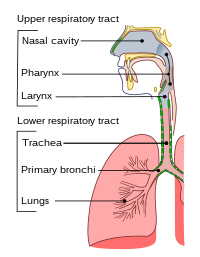
Photo from wikipedia
Nasal irrigation (NI) is an old practice of upper respiratory tract care that likely originated in the Ayurvedic medical tradition. It is used alone or in association with other therapies… Click to show full abstract
Nasal irrigation (NI) is an old practice of upper respiratory tract care that likely originated in the Ayurvedic medical tradition. It is used alone or in association with other therapies in several conditions—including chronic rhinosinusitis and allergic rhinitis—and to treat and prevent upper respiratory tract infections, especially in children. However, despite it being largely prescribed in everyday clinical practice, NI is not included or is only briefly mentioned by experts in the guidelines for treatment of upper respiratory tract diseases. In this review, present knowledge about NI and its relevance in clinical practice is discussed to assist physicians in understanding the available evidence and the potential use of this medical intervention. Analysis of the literature showed that NI seems to be effective in the treatment of several acute and chronic sinonasal conditions. However, although in recent years several new studies have been performed, most of the studies that have evaluated NI have relevant methodologic problems. Only multicenter studies enrolling a great number of subjects can solve the problem of the real relevance of NI, and these studies are urgently needed. Methods for performing NI have to be standardized to determine which solutions, devices and durations of treatment are adequate to obtain favorable results. This seems particularly important for children that suffer a great number of sinonasal problems and might benefit significantly from an inexpensive and simple preventive and therapeutic measure such as NI.
Journal Title: International Journal of Environmental Research and Public Health
Year Published: 2017
Link to full text (if available)
Share on Social Media: Sign Up to like & get
recommendations!